Contrary to my Epithelantha micromeris v. greggii plants that have flowered intensively this summer, I have not seen any flowers on my regular Epithelantha micromeris (SB1327; near Belen, New Mexico), but judging from the fruits they must have snuck out some flowers while I was not watching ;-)
Epithelantha micromeris (SB1327; near Belen, New Mexico) fruits
The fruits are a very bright pinkish red - the color almost defies description but it is the kind of screaming color that would seem fit for jelly beans ;-)
Fruiting Epithelantha micromeris (SB1327; near Belen, New Mexico)
Epithelantha micromeris fruits seen from the top
I scanned one of the fruits to get an up-close look at it and the seeds within.
Epithelantha micromeris fruit, close-up
The seeds are not surrounded by pulp, they just sit inside the "dry" outer skin of the berry. The fruits have a bland, uninteresting taste - I wouldn't grow them for marmalade. 
Epithelantha micromeris fruit, cut open
The Epithelantha micromeris plants are grown in my coldhouse and they don't seem to mind the cold winters at all - according to Steve Brack this variety of Epithelantha micromeris is from the northernmost known locality of the species.
Read more about the (dry) fruits in this post.
Sunday, August 10, 2008
Fruiting Epithelantha micromeris
Sunday, July 20, 2008
New plants for the coldhouse
Last week I received a new batch of plants from Kakteen Kliem. The plants are going to live in my coldhouse so I selected plants originating from habitats where they are naturally exposed to frost - I hope this also gives them the ability to withstand the freezing conditions they have to endure during winter here in Denmark. 
Lophophora williamsii (JJH 8608293; Pecos River, Texas)
I already have several of these Trans-Pecos Lophophora williamsii plants but decided to procure a few more as Kliem’s stock is running low.
Ariocarpus fissuratus (SB 403; Crockett County, Texas)
My few coldhouse grown Ariocarpus fissuratus plants have all survived until now so I felt like adding some more to the collection ;-)
Homalocephala texensis (DJF 891.3; Yoakum County, Texas)
Homalocephala texensis (aptly named the “Horse Crippler”) is a first for me - I’m looking forward to watching these plants grow and develop their characteristic heavy spine armor.
Normanbokea valdeziana (SB 1468; Ramos Arizpe, Coahuila, Mexico)
Normanbokea valdeziana is another first. I’m not quite sure what to expect from these plants but I fell for their fuzzy looks and beautiful flowers.
As always Gerhard Kliem’s plants are of an excellent quality.
Sunday, May 04, 2008
Time-lapse video of a flowering Epithelantha micromeris v. greggii
Most of my coldhouse grown Epithelantha micromeris v. greggii (Cuesta la Muralla, Coahuila, Mexico) flowered big time this week. The plants were started from seed in 2004 and are flowering for the first time.
Flowering Epithelantha micromeris v. greggii
The small creamy, off-white flowers are not spectacular but still quite a beautiful sight, especially when several are blooming at the same time. The following time-lapse video shows a flower going from bud to full bloom.
The pictures used for the time-lapse were taken every 15 seconds over a two hour period. The pictures are played back at a rate of 10 frames per second, i.e. the flowering is speed up by a factor of 150 resulting in a 48 second video. The camera was placed on an old wooden floor resulting in a couple of "wobbly" sequences. The photos were taken using natural light only, the shifting light levels are caused by drifting clouds.
I attempted to cross-pollinate several of the plants and are hoping for seeds next year.
Sunday, March 30, 2008
Lophophora - experiments in cold hardiness, 2008
As mentioned in the previous post on Ariocarpus and Epithelantha I have experimented with coldhouse grown Lophophora since 2004.
Lophophora williamsii (SB 854; Starr Co, Texas), 2004
The Lophophora williamsii (SB 854; Starr Co, Texas) plants from the 2004 batch are still doing great. The plants are growing true to the type with a glaucous bluish-green epidermis. The one on the left flowered last year so I'll soon be able to produce seeds originating from plants that have survived several seasons in an unheated greenhouse. During winter all my Lophophora plants are wrapped in horticultural fleece - both as a protection against the cold but also to keep out hungry pests.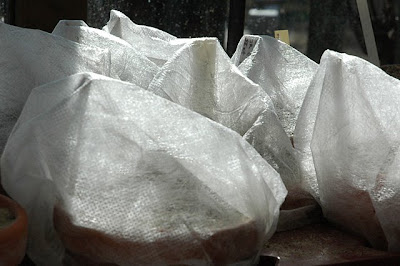
Lophophora plants wrapped in horticultural fleece
Some of the plants needed to be repotted before the upcoming growing season, for example these Lophophora williamsii (SB 854; Starr Co, Texas) plants from the 2005 batch.
Lophophora williamsii (SB 854; Starr Co, Texas), 2005
The plants started from seed in 2005 have grown to 2.5 - 3 cm (~ 1'') in diameter - with a bit of luck they might flower already this summer.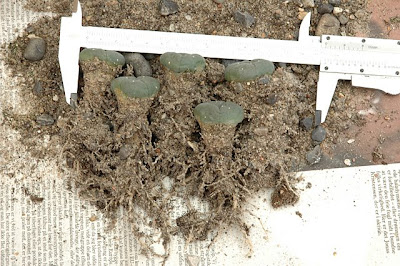
Uprooted Lophophora williamsii (SB 854; Starr Co, Texas), 2005
I never cease to be marveled by how large a fraction of a Lophophora plant that is actually growing underground. The plant pictured below has a crown that is approximately 1 cm high while the massive part of the taproot amounts to 4 times that and the full root system is more than 10 cm long.
Lophophora williamsii (SB 854; Starr Co, Texas) with exposed root, 2005
The past winter was mild - the coldest temperature registered inside the coldhouse was -5C (23F) - so even my Lophophora diffusa and Lophophora decipiens plants have all survived without any signs of damage. 
Lophophora diffusa (Higuerillas, Queretaro, Mexico)
The Lophophora decipiens plants are very shriveled and look in dire need of a drink of water. They'll have to wait for a couple of more weeks in order for the weather to warm up.
Shriveled Lophophora decipiens
Last year I grafted a handful of Lophophora williamsii (SB 854; Starr Co, Texas) seedlings on frost hardy Opuntia compressa (Monmouth County, New Jersey) stock. The grafts seem to be doing well and I'll get back with more information on Opuntia grafting when I've done some more experiments.
Lophophora williamsii (SB 854; Starr Co, Texas) grafted on Opuntia compressa stock
Saturday, March 29, 2008
Ariocarpus and Epithelantha - experiments in cold hardiness, 2008
Since 2004 I've experimented with growing Lophophora, Epithelantha, and Acharagma in an unheated greenhouse in Denmark. Last year I also added some Ariocarpus plants to the experiment, both seed grown and larger plants bought from Mesa garden. This winter has (as usual, I'm tempted to say) been damp but not very cold - the coldest temperature registered inside the coldhouse was -5C (23F) so most plants are doing great. 
Ariocarpus fissuratus (JM122; Pecos County, Texas)
Last year I bought a couple of Ariocarpus fissuratus (JM122; Pecos County, Texas) plants from Mesa Garden. Coming out of winter they are still looking good and seem to have coped well with the cold.
The Epithelantha plants pictured below were started from seed in 2004 and look like they are large enough to start flowering soon. 
Epithelantha micromeris v. greggii (Cuesta la Muralla, Coahuila, Mexico)
Apart from Epithelantha micromeris v. gregii I'm also growing the "regular" variety of Epithelantha micromeris. In my experience the regular micromeris is slightly slower growing than the greggii variety.
Epithelantha micromeris (SB1327; near Belen, New Mexico)
All of my Ariocarpus (including last year's seedlings) and Epithelantha plants made it through winter without damage. The next post describes how my Lophophora plants are doing after the winter.
Saturday, March 31, 2007
Lophophora and Epithelantha - experiments in cold hardiness II
Since 2004 I’ve experimented with growing Lophophora, Epithelantha, and Acharagma in an unheated greenhouse in Denmark. The winter this year has been damp but not very cold - the coldest temperature registered in the coldhouse was -5C (23F) – so even the L. diffusa plants are doing great. 
Lophophora williamsii (SB 854; Starr Co, Texas)
The L. williamsii plants (sown May 2004) are thriving in the coldhouse. The epidermis is glaucous bluish-green, much truer to the type than plants grown in my windowsill. All my cold grown Lophs are wrapped in horticultural fleece during winter – not so much because of the temperature, but to avoid attacks from various critters. This kind of damage is not a problem with the spine covered species.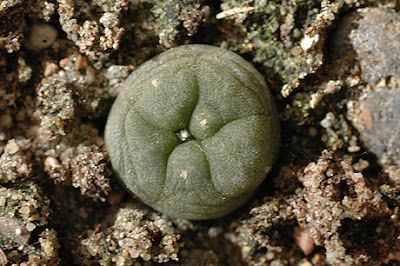
Lophophora diffusa (Higuerillas, Queretaro, Mexico)
In 2005 I sowed L. diffusa and L. decipiens to grow in the coldhouse. Especially the L. diffusa plants had a hard time last winter and only 2 survived. Both are now doing fine and are developing the typical yellowish-green epidermis. 
Lophophora decipiens
L. decipiens is not a “good” species; it’s probably just a cultivar form of Lophophora fricii (I couldn’t obtain any collection data for these seeds either when I bought them). Anyway, the plants are doing well and are getting ready to go 8-ribbed at an age of two.
I’m growing both “regular” Epithelantha micromeres and Epithelantha micromeris v. gregii. The gregii variety seems to be a faster grower than the regular micromeres; it also has a very beautiful coverage of spines, as illustrated below.
Epithelantha micromeris v. greggii (Cuesta la Muralla, Coahuila, Mexico)
Epithelantha micromeris v. greggii – closeup
All of the Epithelantha plants made it through this winter without damage.
Tuesday, May 23, 2006
Lophophora and Epithelantha - experiments in cold hardiness
According to common belief, species from Lophophora, Epithelantha, Ariocarpus etc, do not like subfreezing temperatures. This is not entirely true - many varieties will survive temperatures dropping well below freezing. The last couple of years I've experimented with growing Lophophora, Epithelantha, and Acharagma in an unheated greenhouse, and this winter the plants had to endure temperatures below -10C (14F) for extended periods. I'm planning on growing Ariocarpus as well if I can find seeds originating from the Trans-Pecos area.
Lophophora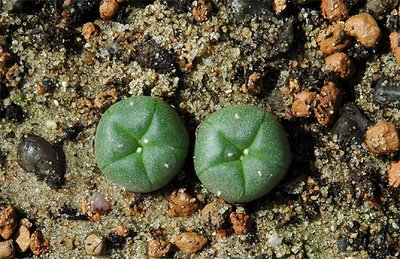
Lophophora williamsii – started from seed 2004
The picture above shows Lophophora williamsii (SB 854; Starr Co, Texas) plants sown May 1, 2004. After 2 years in the coldhouse the plants are thriving - more plants have been disfigured and killed by bush-crickets and other critters than by the cold. The remaining 5 plants are each 1.5 cm (~ 0.6'') wide.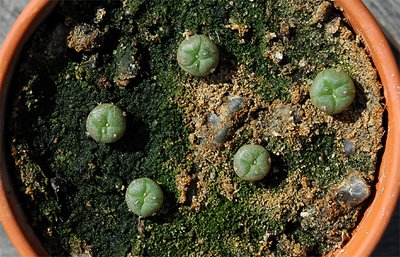
Lophophora williamsii – started from seed 2005
Last years batch of Lophophora williamsii (SB 854; Starr Co, Texas) seedlings are also doing well. The 5 plants have obtained a diameter of 1 cm (~ 0.4'').
The more southern living Lophophora diffusa is not handling the cold as well - none of the plants started from seed in 2004 are left, and only 2 plants from the 2005 crop are still surviving. The L. diffusa seeds originated from plants from Higuerillas, Queretaro. The 11 Lophophora decipiens seedlings from last year are doing slightly better, but as the L. diffusa seedlings they have only grown to a width of 0.5 cm (~0.2'').
Epithelantha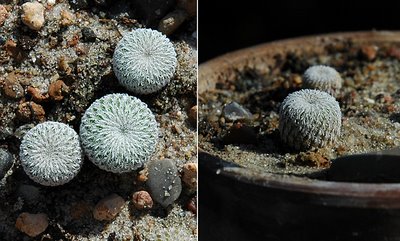
Left: E. micromeris v. greggii (Cuesta la Muralla, Coahuila)
Right: E. micromeris (SB 1327, near Belen, New Mexico)
I'm growing Epithelantha micromeris v. greggii (Cuesta la Muralla, Coahuila) and Epithelantha micromeris (SB 1327, near Belen, New Mexico). The New Mexico variety is a slow grower – the 12 plants are less than 1 cm (~ 0.4'') wide – but it is handling the cold very well. The Coahuila variety is growing faster but is more susceptible to frost damage – the 11 plants are each 1.5 cm (~ 0.6'') wide. All plants were sown May 1, 2004.
Acharagma
The Acharagma aguirreana (RSM 396; Sierra Paila, Coahuila) and Acharagma roseana (LX 578; Ramon Arizpe, Coahuila) seedlings from last year are still fairly small – less than 0.5 cm (~0.2'') in width. A. roseana seems to be better at tolerating frost than A. aguirreana; I sowed 30 seeds of each species, and 20some seedlings of each germinated. Today more than 20 A. roseana are surviving while only 3 A. aguirreana are left.
Tuesday, December 27, 2005
Munching on Lophophora williamsii - II
My cold house grown Lophs have been maimed by some critter eating big, hearty lumps out of them. There are no traces of snails so I expect the culprit to be a grasshopper or bush-cricket trapped in the house.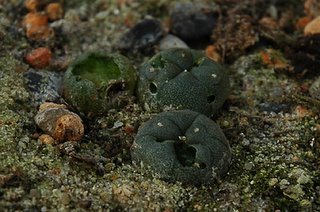
Maimed Lophophora williamsii (SB 854; Starr Co, Texas)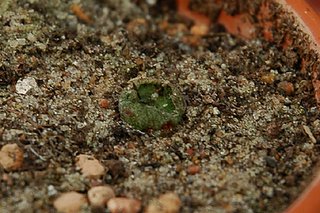
Lophophora diffusa (JR; Higuerillas, Queretaro) remains
The plants above were sown May 1, 2004 and have grown in the cold house since. Some of this year’s Lophophora seedlings were also taken out by the “unwanted guest”.
I’ve wrapped the pots in horticultural fleece and hope this will keep the culprit out in the future.
Monday, August 15, 2005
Munching on Lophophora williamsii
Until lately my coldhouse grown Lophophora williamsii (SB 854; Starr Co, Tx; sowed May 1, 2004) were dazzling in their immaculate appearance – until some critter decided to munch on them.

Munched on Lophophora
The main shoot of my Cylindropuntia tunicata was maimed too. A search of the cacti revealed a great green bush-cricket (Tettigonia viridissima) hiding among the plants. I took the mug shot below before releasing the suspected culprit outdoors.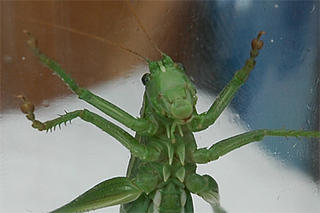
Captured great green bush-cricket
The harm is not too great and I expect the plants to fully recuperate from the damage.
Sunday, July 24, 2005
Sowing in the rough - III
I’m not sure if it’s the seed, the coldhouse environment or sheer coincidence, but in addition to the deviating growth forms described in an earlier post one of the Lophophora williamsii (SB 854; Starr Co, Texas) seedlings turned out achlorophyllous.
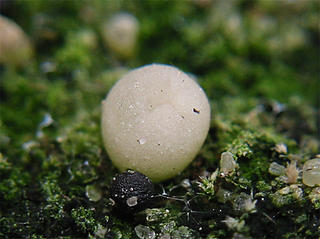
Achlorophyllous Lophophora williamsii
The seedling lacks chlorophyll and will not survive on its own roots for long so I grafted it on Pereskiopsis spathulata – hopefully it will survive and prosper.
< previous |
Monday, July 11, 2005
Sowing in the rough - II
Some of the Lophophora williamsii (RS 268; Huizache, San Luis Potosí) seedlings are developing interesting growth forms. One is clearly dichotomous (a simple type of branching in plants where the apical meristem splits at various intervals) and another shows signs of an extension of the apical meristem into a ridge - I'll watch it closely to see if it develops a crest.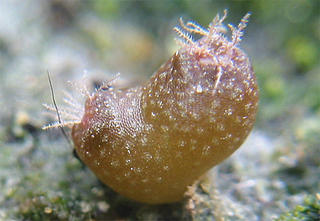
Dichotomous Lophophora williamsii seedling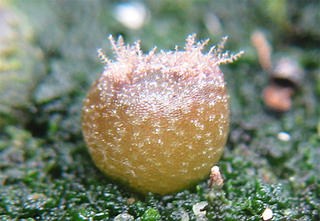
Lophophora williamsii seedling with a crest meristem?
< previous | next >
Saturday, May 14, 2005
Sowing in the rough
If I don’t chicken out, the plants growing from the seeds sown today are going to spend the rest of their lives in an unheated greenhouse in Denmark. 30 seeds of each of the below species were sown.
- Acharagma aguirreana (RSM 396; Sierra Paila, Coahuila)
- Acharagma roseana (LX 578; Ramon Arizpe, Coahuila)
- Lophophora williamsii v.decipiens
- Lophophora williamsii (RS 268; Huizache, San Luis Potosí)
I also sowed some leftovers from last year. 10 seeds each of:
- Lophophora diffusa (JR; Higuerillas, Queretaro)
- Lophophora williamsii (SB 854; Starr Co, Texas)
A cold house batch of the two latter species was also sowed last spring. Most plants survived the winter and are now resuming growth.
| next >
All Time Most Popular Posts
-
On various occasions I've been asked what growing media I'm using for my cactus plants. I don't have a set soil mix recipe as su...
-
Lophophora williamsii (peyote) populations have diminished in large areas of South Texas where peyoteros harvest the cactus for ceremonial ...
-
Below is a list of retailers/nurseries selling cactus seed and plants. I've only listed vendors I've done business with. If you ar...
-
Most cacti are easily grown from seed - and with a little patience and care they can be grown into beautiful plants. Lophophora williamsi...
-
In last month’s post on the troubled Texan peyoteros I referred to Anderson’s article on the peyote situation in Texas. Given the importanc...
-
Yet another slightly off topic and probably not entirely politically correct post, but I couldn’t help noticing the similarity of my monstr...
-
Flowering stand of San Pedro cacti (Trichocereus pachanoi) To me the main draw of the San Pedro cactus ( Trichocereus pachanoi (syn. Ech...
-
In the June 2008 issue of the Cactus & Co magazine Jaroslav Šnicer, Jaroslav Bohata, and Vojtěch Myšák described a new Lophophora spec...
-
There seems to be an increased focus on the alarming Texas peyote situation. A couple of weeks ago the Houston Press published a mournful, i...
-
I spent two weeks working in Delhi, India during January. I had one weekend off and had planned to spend it in Delhi at my own leisure, but ...


















